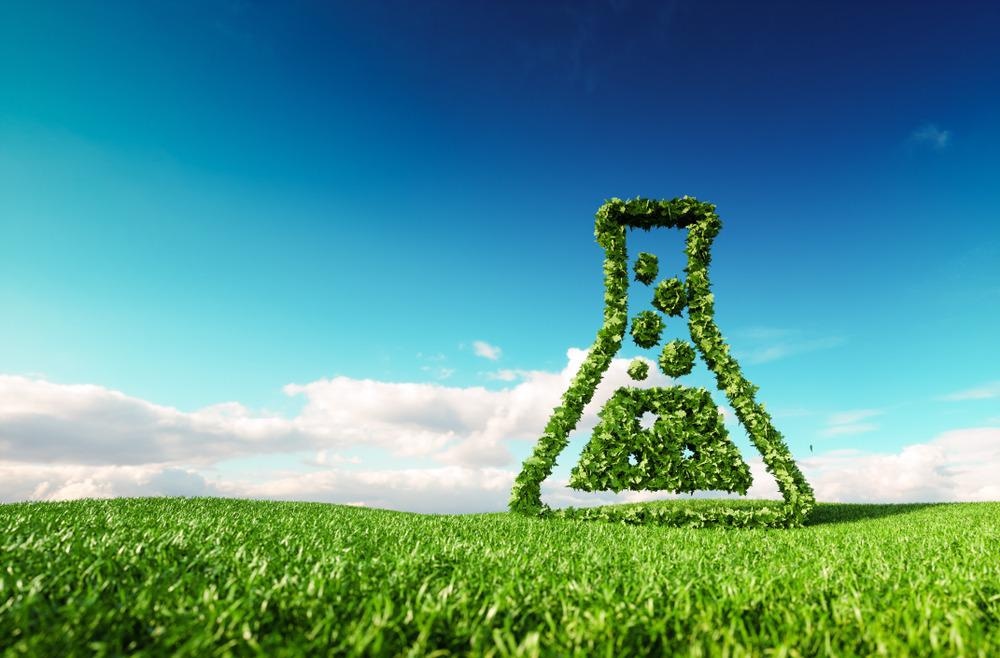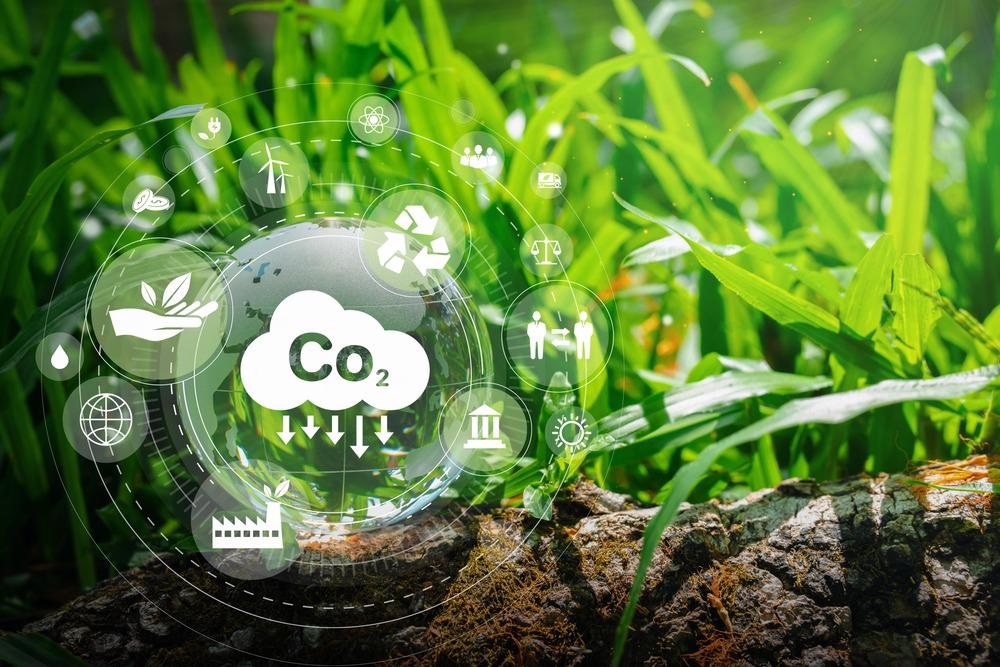The term “green chemistry” refers to the implementation of protocols and chemical products that will diminish or completely negate the formation of hazardous substances and by-products that would cause harm to the environment. Some common examples of green chemistry implementations are supercritical water oxidation and the use of green solvents derived from the processing of staple crops.

Image Credit: petrmalinak/Shutterstock.com
The average global temperature is increasing at a rate of (0.18°C / 0.32°F) per year. Although this may not appear to be significant, preserving a habitable climate will require seizing all greenhouse-gas emissions by the year 2050. In addition to this macabre point, the temperature rise has also dealt a blow to the issue of food security, or the degree of food availability and accessibility.
Carbon Sequestering and CO2 Alleviation Via Crop Diversification and Artificial Selection
To foster solutions, personal investigators like (Michael T. Coe et al.) have made efforts to establish crop species, seasonal patterns, and effective soil profiles that correspond to an increased food yield. They assert that selectively diversifying crop species, resorting and minimizing damage to soil structure, and re-depositing carbon back into the soil can lead to a more conserved nutrient cycle and an increase in carbon sequestration.
Using CO2 sensors has concluded that dryland ecosystems could embody an effective sink for atmospheric carbon, dependent on the level of degradation or “desertification.” In a (Robertson AD et al.) study, the assaying of soil carbon dynamics under average warming, and extensive warming, was conducted based on DayCent process-based models and long-term experimental data. The simulations showed that the reduction of summer fallow (Triticum Aestivum L.) could increase the yields of other harvests and increase the storage capacity of soil carbon.
The logic behind this rests on the principle of evapotranspiration, or the process of relocating water from soil surfaces and plant transpiration into the atmosphere. Evapotranspiration will undeniably increase throughout the next few decades, and because of this, reducing the periods of live vegetation of summer fallow from dryland agriculture and seeding another biome may prove effective. Their models found that this increase in biodiversity amongst dryland seeding rotations could improve the resilience of these biomes to climate change. In tandem, this method may also increase the soil carbon storage, alleviating the atmosphere of CO2.
Treatments in drylands have begun, with the rotational crops consisting of wheat-corn-millet-fallow, wheat-corn-fallow (WCF), and other species. The desired crops were selected according to market trends and aided in maintaining soil carbon stocks in these agroecosystems while leveling out yields. More specifically, these treatments resulted in more extensive soil carbon stocks and net sequestration. The representative concentration pathway (RCP) (a plot of greenhouse gas concentration over time, founded by the Intergovernmental Panel on Climate Change (IPCC)) showed to be 4.5 in more average warming and 8.5 under extensive warming-a positive trend.
Another approach to alleviating food security that is centuries old is artificial selection. By employing opportunities for climate-resilient crops to grow, our food security could be improved as these anticipated temperature rises come to pass. Again, by removing summer fallow requirements and quotas and replacing them with more diverse grains, total production in North American regions could increase by 25% while increasing farm income by 26%. In addition, this will critically offset greenhouse gas emissions prompted by dryland (Rosenzweig and Schipanski 2019).
Government Policy Intervention
Our inability to implement a peer-reviewed, policy-driven attack on climate change is comparatively affected by the legislative burden, lack of political capital, and bureaucracy that is fixed to the green party. We have seen a very gradual transition to conservation agriculture and green policies within the goings of politics. However, we must find new approaches to make up for this lack of hurriedness.
More progressive conglomerates and food suppliers are confronting these climate tribulations with extensive food analysis. This combines the principles of green chemistry, green analytical chemistry, and sustainable development goals. Some standards that make up these principles are axiomatic, such as “prevent waste” or “eliminate or replace toxic agents.”
In contrast, some standards may not be as widely known to the public, like “avoid chemical derivatizations,” “use catalysts rather than stoichiometric reagents,” or “carrying out in situ measurements.” If the general populace, as well as the heads of certain firms and corporations, adopt these policies, we could sustain a more habitable environment and see a dramatic decrease in greenhouse-gas emissions.

Image Credit: d.ee_angelo/Shutterstock.com
Refinement of Bioactivity in Tackling Food Security
A practice that amasses less attraction in the media, and indeed in the fields of green chemistry, is the increase in our existing harvests bioactivity. “Increasing Bioactivity” relates to the recovery and creation of bioactive compounds in existing foods. Not only will increasing the bioactivity of our food storage help to tackle food security, but it will also contribute to a healthier lifestyle and a sense of well-being.
Researcher teams like (D. Ballesteros-Vivas et al.) endeavor to characterize and categorize the main bioactive molecules found in all by-products, whether they be natural foods, wastes, processed foods, or agri-food. By implementing ethical, analytical approaches to foodomics, the “greenness” involved in food processes and productions can be refined.
The field of foodomics, in conjunction with proteomics, metabolomics, and other subdivisions of science, has led to the overall increase in food bioactivity. Some methodologies include gas chromatography-mass spectroscopy (GC-MS) in assessing bioactive metabolites in sugarcane by-products and ultra-high performance liquid chromatography (UHPLC) in assessing flavonoids in Passiflora waste and the usage of paper microzone plates in testing for Antioxidant capacity and total phenolic content.

 Continue Reading: The Future of Sustainable Agriculture
Continue Reading: The Future of Sustainable Agriculture
Sources:
- Coe, MT, Evans, KM, Gasic, K, Main, D. Plant breeding capacity in U.S. public institutions. Crop Science. 2020; 60: 2373– 2385. https://doi.org/10.1002/csc2.20227
- Robertson AD, Zhang Y, Sherrod LA, Rosenzweig ST, Ma L, Ahuja L, Schipanski ME. Climate Change Impacts on Yields and Soil Carbon in Row Crop Dryland Agriculture. J Environ Qual. 2018 Jul;47(4):684-694. doi: 10.2134/jeq2017.08.0309. PMID: 30025064.
- D. Ballesteros-Vivas, G. Alvarez-Rivera, E. Ibánez, F. Parada-Alfonso, A. Cifuentes
- Integrated strategy for the extraction and profiling of bioactive metabolites from Passiflora mollissima seeds combining pressurized-liquid extraction and gas/liquid chromatography–high resolution mass spectrometry J Chromatogr A, 1595 (2019), pp. 144-157,
- D. Ballesteros-Vivas, G. Alvarez-Rivera, C. León, S.J. Morantes, E. Ibánez, F. Parada-Alfonso, A. Cifuentes, A. Valdés Foodomics evaluation of the anti-proliferative potential of Passiflora mollissima seeds Food Res Int, 130 (2020)
- Prestele, R., Hirsch, A. L., Davin, E. L., Seneviratne, S. I., & Verburg, P. H. (2018). A spatially explicit representation of conservation agriculture for application in global change studies. Global change biology, 24(9), 4038–4053. https://doi.org/10.1111/gcb.14307
- Jahangirian, H., Lemraski, E. G., Rafiee-Moghaddam, R., & Webster, T. J. (2018). A review of using green chemistry methods for biomaterials in tissue engineering. International journal of nanomedicine, 13, 5953–5969. https://doi.org/10.2147/IJN.S163399
- Chen TL, Kim H, Pan SY, Tseng PC, Lin YP, Chiang PC. Implementation of green chemistry principles in circular economy system towards sustainable development goals: Challenges and perspectives. Sci Total Environ. 2020 May 10;716:136998. doi: 10.1016/j.scitotenv.2020.136998. Epub 2020 Jan 30. PMID: 32044483.
- Anderson JA, Gipmans M, Hurst S, Layton R, Nehra N, Pickett J, Shah DM, Souza TL, Tripathi L. Emerging Agricultural Biotechnologies for Sustainable Agriculture and Food Security. J Agric Food Chem. 2016 Jan 20;64(2):383-93. doi: 10.1021/acs.jafc.5b04543. Epub 2016 Jan 11. PMID: 26785813.
Further Reading
Last Updated: Jul 12, 2022